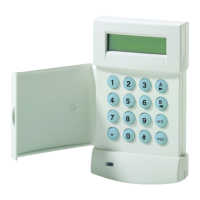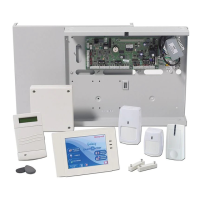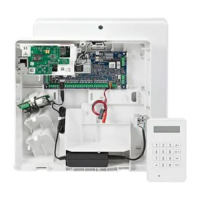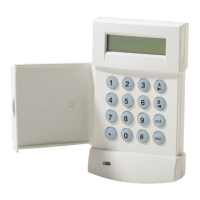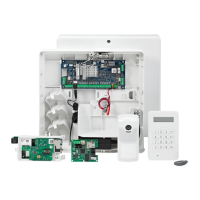Do you have a question about the Honeywell Galaxy 128 and is the answer not in the manual?
Details the Galaxy Mk7 LCD keypads and their connection limits to control panels.
Used for entering codes, selecting options, and programming system groups.
Activate system options, step through lists, and navigate information displays.
Accepts entered data, performs valid actions, and moves to the next option.
Aborts current options, returns to previous levels, or exits setting routines.
Displays additional choices or acts as a duress key when pressed twice.
Provides additional features for certain options, such as printing or deleting.
Indicates system power status: green for normal, flashing for failures.
Shows system status, time, and date when unset; blank when set.
Unique 4, 5, or 6 digit PINs for user identification and system operation.
Ensure doors/windows are secured and detector areas are clear before system setting.
Procedure for users to enter their PIN to initiate the system setting routine.
PIN entry method for higher user levels to start the setting routine.
Select groups to set; displays group status (Ready, Faulted, Set, Lockout).
Time allocated to vacate premises after initiating the system setting routine.
Describes sounder tones (continuous, pulsing) indicating zone status and time remaining.
Handling of open zones; alarms occur if not resolved before setting expires.
Procedure for manually completing setting via final door or terminator button.
Confirmation message and tones indicate the system has been successfully set.
Setting only specific zones that have the PART attribute enabled.
Aborting the setting process by pressing the 'esc' key before system arming.
Shows programmed names for groups by simultaneously pressing '*' and '#' keys.
Using MicroMAX cards/fobs to set the system by holding them to a reader module.
Requires both PIN and MAX card entry for operation, enhancing security.
Keypads with built-in card readers, commonly used for dual focus functions.
Unsetting initiated by opening the FINAL door or activating an ENTRY zone.
Entering protected areas before unsetting can trigger a full alarm.
Enter a valid PIN before entry time expires to avoid a full alarm.
Cancel alarms by entering a valid PIN; may require specific reset authorization.
Resets the system after an alarm using a manager-level PIN.
Requires an engineer visit and reset for certain alarm types.
Using MicroMAX cards to unset system groups when they are currently set.
Accessed by Manager code on specific models; provides comprehensive system access.
Default menu for most users; offers a selection of up to 10 numbered options.
Procedure to enter menus using a valid code and the 'ent' key.
Allows users to omit eligible zones for one set period before system arming.
Steps to select the '0=OMIT ZONES' option from the Quick Menu.
How to view zones eligible for omission using A> or <B keys.
Omit a zone by pressing the '#' key; omission is immediate.
Starting the setting routine after zones have been selected for omission.
Galaxy 512 permits omission of only one eligible zone at a time.
Omitting one vibration zone blocks all similar zones in all groups.
Omitting ATM zones using specific codes for delay access periods.
Automatically omits eligible open zones during the setting routine for one period.
Steps to select '1 = FORCED SET' from the Quick Menu.
Open zones that cannot be omitted must be closed before setting can continue.
Switches Chime mode on/off; activated zones chime momentarily when opened.
Steps to select '2 = CHIME' and toggle the ON/OFF status.
Chime is active until switched off; suspended during system set or alarms.
Accesses mode to check zone descriptions and current status.
Steps to select '3 = DISPLAY ZONES' from the Quick Menu.
Unique four-digit address number for zone identification and selection.
Displays the zone's operation, e.g., INTRUDER or FIRE.
Shows current zone status (Open/Closed) alternating with function information.
Alpha-numeric text describing the zone's detail, e.g., West Office Door.
View zone details sequentially using A>/<B keys or by zone address.
The 'esc' key aborts the option and returns to the main option menu.
View system history; events are recorded and stored in non-volatile memory.
Steps to select '4 = DISPLAY LOG' from the Quick Menu.
Events include setting, unsetting, and alarms, with time and date stamps.
Navigate through dates using view keys to find specific events.
Progressively step through events of a selected date using A>/<B keys.
Obtain a hard copy print-out of system details; requires a serial printer.
Steps to select '5 = PRINT' from the Quick Menu.
Print-out of user numbers, names, levels, and code lengths.
Print-out of zone addresses, functions, and descriptions.
Print-out of the entire log, detailing time/date of operations.
Print-out of codes, zones, and log data, starting with user codes.
Message displayed if the printer is off-line or not connected.
Tests zones to ensure correct operation; sounder indicates open zones.
Steps to select '6 = Walk Test' from the Quick Menu.
Starts immediate test of all valid zones; sounder indicates zone status.
Allows selection of specific zones for testing using navigation keys.
Abort test with 'esc' or it automatically ends after 20 minutes.
Allows modification of system time (HH:MM) and date (DD/MM/YY).
Steps to select '7 = TIME/DATE' and choose time or date modification.
Procedure to enter a new time (HH:MM) with system validation checks.
Procedure to enter a new date (DD/MM/YY) with system validation checks.
Adjust system time by seconds per week to compensate for clock speed variations.
Enables managers to allocate PINs and related information to system users.
Accesses PIN, level, name, time zones, and MAX details for individual users.
Sets notification period before PIN expiry, prompting mandatory PIN changes.
Assigns MAX cards to users without PINs for Access Control functions.
Authorised to program user codes, allocate codes, and modify PINs.
Manager code defaults to accessing the quick menu on these models.
Steps to select '8 = CODES' from the Quick Menu.
Assigns or modifies a user's PIN; handles uniqueness and duplicate entries.
Erases existing PIN entries using the '*' key; hollow square indicates no PIN.
Programs a user code as Dual Code using '#' key for enhanced security.
Requires a second code within 60 seconds; highest level code determines access.
User access level dictates the menu options available to them.
Details user levels (Guard, Cleaner, Users, Manager) and their access availability.
Assigns a code as Duress; activation triggers programmed Duress or PA outputs.
Assigns a name (max 8 characters) to a user; defaults to USER or MGR.
Disables user PIN access during programmed Timer A and Timer B periods.
Temporarily assigns a PIN to a user for a specified number of days.
Prompts users to assign a new PIN periodically via notification.
Assigns user access and operational control over system groups.
Details group blocks and assignment using keypad keys.
User assigned to one group, can only access, set, and unset that group.
Users allocated to multiple groups for collective access and operation.
Users select which allocated groups to view, set, or unset; enabled by '*'.
Assigns a MAX card by entering its unique 10-digit laser-etched number.
Assigns a MAX card to a specific menu option for user access.
Restricts the MAX card's operation to a single specified keypad.
MAX function activated when card is held to reader for three seconds.
Prevents multiple card uses at readers within a time period; clears restrictions.
Determines days for notification before PIN Change expiry, prompting new PIN.
Assigns MAX users without PINs for operating Access Control functions.
Assigns group access to MAX user, common to module for access control.
Sets British Summer Time start/end dates for automatic clock adjustment.
Summer option modification is engineer-only for Galaxy 504 models.
Advises system is in use; Galaxy 8/18 allow only one user at a time.
System is in alarm condition; must be cancelled by PIN or keyswitch.
PA zone activated; requires high-level code (manager/engineer) for reset.
Alarm activation requires reset by a manager-level PIN.
System requires engineer visit and reset for certain alarm types.
Log is empty or no omittable zones are available.
Selected option or entered value is illegal or out of range.
Entered code is not a valid registered code in the system memory.
Option provided by engineer; attempting selection displays this message.
Call Alarm Monitoring Station for a code to reset the system.
Exiting Engineer Mode when module count change is not detected.
| Zones | Up to 128 |
|---|---|
| Partitions | 8 |
| User Codes | Up to 250 |
| Keypads | Up to 16 |
| Event Log | Up to 1000 events |
| Type | Hybrid (wired and wireless) |
| Battery Backup | 7Ah |
| Weight | 3.5 kg |


